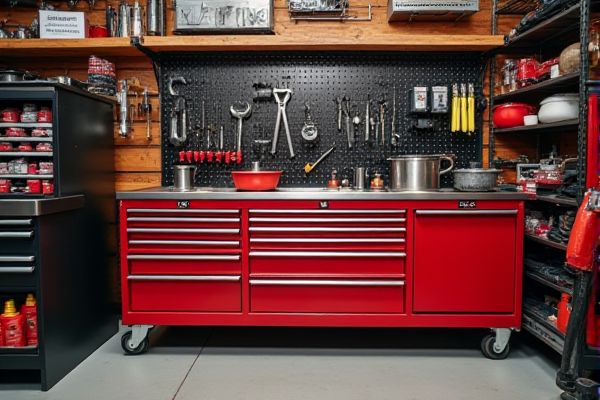
A tool rack offers open, easily accessible storage ideal for frequently used tools, while a tool chest provides secure, enclosed compartments for organizing and protecting a larger collection. Discover how choosing the right option can enhance your workspace efficiency by reading the rest of the article.
Table of Comparison
| Feature | Tool Rack | Tool Chest |
|---|---|---|
| Purpose | Organizes and displays frequently used tools | Secures and stores a wide range of tools |
| Storage Capacity | Limited to hanging tools | Multiple drawers and compartments |
| Portability | Often wall-mounted or stationary | Usually mobile with wheels |
| Security | Minimal security features | Lockable for tool protection |
| Material | Metal or wood, open design | Metal with enclosed drawers |
| Best Use Case | Quick access and tool visibility | Comprehensive storage and protection |
| Cost | Generally more affordable | Higher price due to features |
Introduction: Tool Rack vs Tool Chest
A tool rack offers open storage, making it easy to access and organize frequently used tools, whereas a tool chest provides secure, enclosed compartments that protect your tools from dust and damage. Tool chests often feature multiple drawers and lockable lids for enhanced security, ideal for valuable or specialized tools. Your choice depends on whether you prioritize quick accessibility or secure, long-term storage.
Defining Tool Racks
Tool racks are storage units designed to organize and display hand tools such as wrenches, screwdrivers, and hammers for easy access. Unlike tool chests, which typically feature enclosed drawers and compartments, tool racks provide open, vertical or horizontal holders that keep tools visible and readily available. Their design prioritizes quick tool retrieval and efficient workspace organization, making them ideal for workshops and garages.
Understanding Tool Chests
Tool chests offer organized storage with multiple drawers designed to protect and categorize hand tools, making them ideal for precision work environments. Unlike tool racks, which typically provide open and accessible storage for frequently used tools, tool chests prioritize security and compactness. Their robust construction often includes locking mechanisms, ensuring tool safety and efficient space utilization in workshops.
Storage Capacity Comparison
Tool racks offer open, easily accessible storage ideal for frequently used tools but typically provide less overall capacity than tool chests. Tool chests feature multiple drawers and compartments, maximizing storage space and organization for a large number of tools. When choosing between the two, consider your need for storage capacity versus quick access to optimize your workspace efficiency.
Accessibility and Convenience
A tool rack offers superior accessibility by keeping your tools visible and within easy reach, which speeds up your workflow during projects. Tool chests provide better organization and protection with multiple drawers but may require extra time to open and locate specific tools. Your choice depends on whether you prioritize quick access or secure storage for your tools.
Space Efficiency: Which Saves More Room?
A tool rack maximizes space efficiency by utilizing vertical storage, allowing easy access while occupying minimal floor area, ideal for small workshops or garages. Tool chests, although bulkier, provide enclosed compartments that protect tools from dust and damage but take up more horizontal space. Choosing between the two depends on prioritizing compact vertical storage versus organized, secure tool containment.
Tool Organization and Visibility
Tool racks provide open storage that enhances visibility and quick access to frequently used tools, making them ideal for organizing hand tools and power tools in a workspace. Tool chests feature enclosed drawers that protect tools from dust and damage while offering segmented compartments for systematic organization, improving tool security and inventory management. Selecting between a tool rack and tool chest depends on prioritizing visibility and ease of access versus protection and detailed organization.
Durability and Material Considerations
Tool racks typically feature open designs made from steel or aluminum, offering durability with easy access but less protection from dust and impact. Tool chests, constructed from heavy-duty steel and often coated with powder finishes, provide enhanced durability and protection for your tools against corrosion and physical damage. Choosing between them depends on whether you prioritize the robust safeguard of a tool chest or the lightweight, accessible design of a tool rack.
Cost Analysis: Tool Rack vs Tool Chest
Tool racks typically cost less than tool chests due to their open design and simpler construction, making them ideal for budget-conscious users seeking easy access to frequently used tools. Tool chests, though generally more expensive, offer enhanced security, organization, and protection from dust and damage, which can justify the higher investment for serious DIYers or professionals. Your choice depends on balancing initial costs with long-term benefits like durability and tool management efficiency.
Choosing the Right Option for Your Workshop
Selecting between a tool rack and a tool chest depends on your workshop's space and organization needs. Tool racks offer easy access and visibility for frequently used tools, making them ideal for open, busy workspaces. Tool chests provide secure, compact storage with multiple drawers, perfect for protecting tools from dust and maximizing space in smaller workshops.
 homyna.com
homyna.com